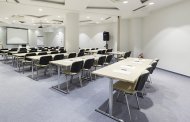how to Design room layout
 Modern-day business is experiencing a digital revolution. Today’s organisations are embracing the benefits of technology, and seizing the opportunities offered by advancements such as flexible working, hot desking, and unified communications. Yet despite the ever-changing landscape, there is one cornerstone of business that remains stoic – the meeting room.
Modern-day business is experiencing a digital revolution. Today’s organisations are embracing the benefits of technology, and seizing the opportunities offered by advancements such as flexible working, hot desking, and unified communications. Yet despite the ever-changing landscape, there is one cornerstone of business that remains stoic – the meeting room.
Meetings offer a plethora of applicational benefits for business, including problem-solving, decision-making, information-presentation and even functioning as a basis for practical training exercises.
We know that having the right room layout is fundamental to the success of the meeting itself, so here are 5 meeting room layout designs that can be used for any occasion:
1. The Boardroom
 The boardroom style is a classic layout which promotes debate and discussion. Perhaps the most familiar of all meeting room layout designs, the boardroom style works extremely well if the group is reasonably small and will spend much of the time talking to one another, or listening to one or two key speakers.
The boardroom style is a classic layout which promotes debate and discussion. Perhaps the most familiar of all meeting room layout designs, the boardroom style works extremely well if the group is reasonably small and will spend much of the time talking to one another, or listening to one or two key speakers.
Popular for board meetings, team meetings, and mergers, the boardroom layout promotes a hierarchical control system where those parties at the head of the table have most control over proceedings. The main drawback of using this style is that it offers poor viewing capabilities if there is a requirement for a presentation.
2. The Horseshoe
The horseshoe is like the boardroom in many respects, and the style is equally conducive to discussion and debate. Its layout tends to suit a greater number of participants however, and it can be a far better choice than the boardroom when delivering presentations – which can be performed within the middle of the ‘shoe’ so that participant views are not impaired.
Predominantly preferred by trainers, the style and shape enables interaction on a large scale as well as on a one-to-one level. This helps to increase the integration of the participants as they can concentrate on a common environment, and affords the trainer or key speaker a certain level of attention and respect as the focal point of the room.
3. The Classroom
The classroom style is another classic meeting room layout and one which helps to promote the focus and concentration of its participants. The classroom design is beneficial when there needs to be a primary emphasis toward the front of the room and where discussion is not likely to occur – such as a key note speaker delivering a seminar.
Used most effectively in a teaching format or panel discussion, the classroom provides desk facilities so that apparatus such as pen & paper, tablets and computers can be used easily – enabling extensive note-taking as is often required.
4. The Round Table
The round table is a layout that is known for being as much symbolic as it is beneficial to business. Born out of the exploits of King Arthur and his knights, the round table represents equality for all participants and flattens hierarchies (as seen in the boardroom example). The benefits of this style extend past just symbolism however and the face-to-face interaction of all participants helps to significantly boost productivity and innovation.


Related posts:

 Layout for Small Rooms Strip/Basic Home Office Layout. C. Roseberry Create a Functional and Organized Workspace Tired of working in your home office because it s…
Layout for Small Rooms Strip/Basic Home Office Layout. C. Roseberry Create a Functional and Organized Workspace Tired of working in your home office because it s… This cozied-up formal dining room is wonderful for those who have a large family or group of friends and often find themselves throwing dinner parties or hosting…
This cozied-up formal dining room is wonderful for those who have a large family or group of friends and often find themselves throwing dinner parties or hosting… Will it work in the space I have planned? Our published dimensions (e.g. 93 Wx46 Dx32 H) width x depth x height in inches, will help you decide if your furniture…
Will it work in the space I have planned? Our published dimensions (e.g. 93 Wx46 Dx32 H) width x depth x height in inches, will help you decide if your furniture… Schlafzimmer: Ideen, von der Einrichtung bis zur Deko Überlegen Sie sich vor dem Einrichten die Anordnung Ihrer Schlafzimmermöbel. Ist der perfekte Standort für…
Schlafzimmer: Ideen, von der Einrichtung bis zur Deko Überlegen Sie sich vor dem Einrichten die Anordnung Ihrer Schlafzimmermöbel. Ist der perfekte Standort für… Like Architecture & Interior Design? Follow Us A three-bedroom home can be the perfect size for a wide variety of arrangements. Three bedrooms can offer…
Like Architecture & Interior Design? Follow Us A three-bedroom home can be the perfect size for a wide variety of arrangements. Three bedrooms can offer…